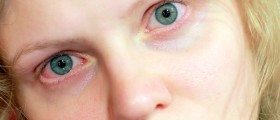
There are many different kinds of infections that can affect the human eyes. Basically, any infectious agent can cause an infectious eye disease, but some, like conjunctivitis, are more common than others. In order to successfully treat an eye infection, it is necessary to determine its exact cause.
Basing on the cause of the infection, eye infections can be classified into several types.
Types of eye infections in adults
Eye infections in adults can be classified according to their cause. Depending on the cause, these infections can be viral, bacterial and fungal in nature.
Many of the most common eye infections in adults are viral — caused by viruses. Conjunctivitis, also called pink eye, which is by far the most common eye infection in the world, can be caused by a virus or by bacteria, and, less commonly, by a fungus.
Viral conjunctivitis, which is contagious and easily passed from one person to another, is caused by adenovirus. It is not a dangerous eye disease and it goes away soon without any specific treatment.
Bacterial conjunctivitis is more typical for children than for adults and it tends to last longer than the viral type of this eye infection. Bacterial conjunctivitis is usually caused by streptococcal bacteria.
Other viral eye infections in adults include those caused by hepatitis B, herpes simplex (which usually causes cold sores but can also affect the eye), influenza, shingles (which is the reactivation of the chickenpox virus), mononucleosis and several other, less common viruses.
Bacterial infections of the eye include streptococcus or staphylococcus infections, sexually transmitted diseases such as chlamydia and gonorrhea, bacterial keratitis, leprosy, tuberculosis and others.
Mycosis is a general term for fungal infections and when it affects the eyes it is usually caused by Candida albicans, but there are over 60 different fungus types that can cause eye infections.
Some of the parasitical eye infections include acanthamoeba, toxoplasmosis and crab lice.
Treatment of Eye Infections in Adults
Just like any other disease, eye infections are treated according to their exact cause. Viral eye infections are generally not treated with medications and home remedies such as chamomile tea bags, salt water, and warm compresses are used instead, to speed up the recovery. For viral infections such as herpes, certain measures are required to prevent future flare-ups.
Bacterial infections are treated with antibiotics, depending on the specific bacterial type. In many cases topical medications in form of eye drops or ointments are sufficient, but in more severe infections it may be required to take oral antibiotics to entirely clear up the infection as well.
Many fungal and parasitical infections also go away on their own without any particular treatment. However, antifungal eye drops are available over the counter.
For severe diseases, such as tuberculosis, syphilis, toxoplasmosis and such, the body needs to be treated as a whole in order for all the parts to get better, including eye problems.
Since it is not possible to determine the cause of an eye infection without a professional diagnosis, and since some eye infections are more serious in nature, you are advised to go to the doctor if you notice an eye infection. Although you may feel silly for going to the doctor for an infection that you later find out will go away on its own in no time, those infections caused by conditions like syphilis need timely treatment to prevent more serious complications.



_f_280x120.jpg)













Your thoughts on this
Loading...